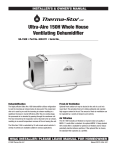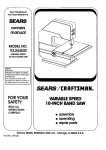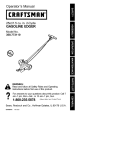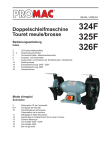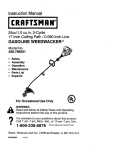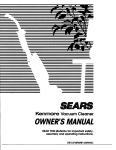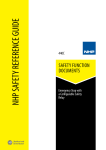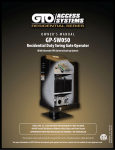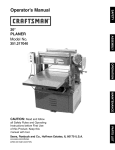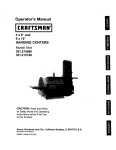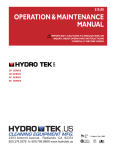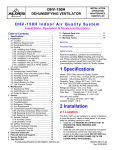Download Craftsman 113.244580 Owner`s manual
Transcript
f Save This Manual For Future Reference S£ARS owner's manual Model No. 113,244580 Two Wheel 9 Inch Band Saw Serial Number Model and serial numbers may be found at the rear of the base. You should record both model and serial number in a safe place for future use. FOR YOUR SAFETY READ ALL INSTRUCTIONS CAREFULLY SE/ Uq S/CRAFTSMAN TWO WHEEL 9 INCH BAND SAW • assembly • operating • repair parts J Sears, Roebuck Part No. SP5872 and Co., Hoffman Estates, IL. 60179 U.S.A. Printed in Taiwan FULL ONE YEAR WARRANTY ON CRAFTSMAN BAND SAW If within one year from the date of purchase, this Craftsman Band Saw fails due to a defect in material or workmanship, Sears will repair it, free of charge. WARRANTY SERVICE IS AVAILABLE BY SIMPLY CONTACTING THE NEAREST SEARS SERVICE CENTER/DEPARTMENT THROUGHOUT THE UNITED STATES, This warranty applies only while this product is used in the United States. This warranty state to state. gives you specific legal rights, and you may also have other rights which vary from Sears, Roebuck and Co., D/817 WA Hoffman Estates, IL 60179 Safety Instructions For Band Saw Safety Signal Words: DANGER: means if the safety information is not followed someone will be seriously injured or killed. WARNING: means if the safety information is not followed someone could be seriously injured or killed. CAUTION: means if the safety information is not followed someone may be injured. Before Using The Saw: I ous, permanent injury, do not plug the saw in until I WARNING: to avoid mistakes that could cause seri- I the following steps have been completed. • Completely assemble and align saw (see "Assembly" and "Alignment" section within). • Learn the use and function of the ON-OFF switch, table bevel and bevel lock knob, blade guides, backup bearings and blade guard. • Review and understand all safety instructions and operating procedures in this manual. • Review the maintenance methods for this saw. • Find and read all the warning labels found on the front of the saw (shown below). When Installing or Moving the Saw: Avoid dangerous environment. • Use the saw in a dry, indoor place protected from rain. • Keep work area well lighted. To avoid injury from unexpected saw movement. • Put the saw on a firm level surface where there is plenty of room to handle and properly support the workpiece. • Support the saw so the table is level and the saw does not rock. ADVSmlENClA ALLOW TOO L TO sTOp BEFORE ADJUSTING _EQUE LA HERRAf£Ek'TA SE DETENGAANTES DEI_.ALIZ_ _JSl"ES • Bolt the saw to the floor or work surface. Saw may slip, walk or slide while cutting long or heavy boards. • Turn saw off and unplug cord before moving the saw. To avoid injury from electrical shock. • Make sure your fingers do not touch the plug's metal prongs when plugging in or unplugging the saw. • Never stand on tool. Serious injury could occur if the tool tips or you accidentally hit the cutting tool. Do not store any items above or near the tool where anyone might stand on the tool to reach them. Before Each Use: Inspect your saw. • To avoid injury from accidental starting, turn the switch off, unplug the saw, and remove the switch key before changing the setup, removing covers, guards or blade. • Check for alignment of moving parts, binding of moving parts, breakage of parts, saw stability, and any other conditions that may affect the way the saw works. • If any part is missing, bent or broken in any way, or any electrical part does not work properly, turn the saw off and unplug the saw. • Replace damaged or missing parts before using the saw again. • Maintain tools with care, Keep the saw clean for best and safest performance. Follow instructions for lubricating. • Remove adjusting keys and wrenches. Form a habit of checking for and removing keys and adjusting wrenches from table top before turning it on. To avoid injury from jams, slips, thrown pieces or broken blades. Inspect your blade. ; Do not wear loose clothing, gloves, neckties or jewelry (rings, wrist watches). They can get caught and draw you into moving parts. • Choose the right blade size, style and cutting speed for the material and the type of cutting you plan to do, • Wear nonslip footwear. • Use only recommended accessories. Consult this owners manual for recommended accessories. Follow the instructions that come with the accessories. The use of improper accessories may cause risk of injury to persons. • Roll long sleeves above the elbow. • Make sure the blade teeth point downward, toward the table. • Make sure the blade guides and thrust bearings are properly adjusted. • Make sure the blade tension is properly adjusted. • Make sure the bevel clamp is tight and no parts have excessive play. • To avoid accidental blade contact, minimize blade breakage and provide maximum blade support, always adjust the upper blade guide and blade guard to just clear the workpiece. Inspect your work area. • Keep work area clean. • Cluttered areas and benches invite accidents. must not be slippery from wax or sawdust. Floor • To avoid burns or other fire damage, never use the saw near flammable liquids, vapors or gases. Plan Your Work. • Use the right tool. Don't force tool or attachment to do a job it was not designed to do. • Use this band saw to cut only wood, wood like products and plastics. CAUTION: To avoid blade breakage, fire or other damage to the saw, never use this band saw to cut metals, • To avoid injury from accidental contact with moving parts, don't do layout, assembly, or set up work on the saw while any parts are moving. • Avoid accidental starting. Make sure switch is "OFF" before plugging saw into a power outlet. • Plan ahead to protect your eyes, hands, face and ears. Dress for safety • Any power saw can throw foreign objects into the eyes. This can cause permanent eye damage. Wear safety goggles (not glasses) that comply with ANSI Z87.1 (shown on package). Everyday eyeglasses have only impact resistance lenses. They are not safety glasses. Safety goggles are available at Sears retail stores. Glasses or goggles not in compliance with ANSI Z87.1 could seriously hurt you when they break. WEAR YOUR • Tie back long hair. • Noise levels vary widely. To avoid possible hearing damage, wear ear plugs or muffs when using saw for hours at a time. • For dusty operations, wear a dust mask along with the safety goggles. Inspect your workpiece. Make sure there are no nails or foreign objects in the part of the workpiece to be cut. Use extra caution with large, very small or awkward workpieces: • Use extra supports (tables, saw horses, blocks, etc.) for any workpieces large enough to tip when not held down to the table top. • Never use another person as a substitute for a table extension, or as additional support for a workpiece that is longer or wider than the basic saw table, or to help feed, support or pull the workpiece. • When cutting irregularly shaped workpieces, plan your work so it will not slip and pinch the blade. A piece of molding for example, must lie flat or be held by a fixture or jig that will not let it twist, rock or slip while being cut. • Properly support round material such as dowel rods, or tubing. They tend to roll during a cut, causing the blade to "bite". To avoid this, always use a "V" block or clamp the work to the miter gage. • Cut only one workpiece at a time. • Clear everything except the workpiece and related support devices off the table before turning the saw on. Plan the Way You Will Hold the Workpiece From Start To Finish. • Do not hand hold pieces so small that your fingers will go under the blade guard. Use jigs or fixtures to hold the work and keep your hands away from the blade. • Secure work. Use clamps to hold work when practical. It's often safer than using your hand, and frees both hands to operate the tool. • Don't overreach. Keep good footing and balance. Safety Instructions for Band Saws (continued) Whenever Sawblade Is Moving: • Wait for all moving parts to stop. • Remove switch key. WARNING: Don't let familiarity (gained from frequent use of your band saw) cause a careless mistake. Always remember that a careless fraction of a second is enough to cause a severe injury. When backing up the workpiece, the blade may bind in the kerr (cut). This is usually caused by sawdust clogging up the kerf or because the blade comes out of the guides. If this happens: • Turn saw "OFF" • Before starting your cut, watch the saw while it runs. If it makes an unfamiliar noise or vibrates a lot, stop immediately. Turn the saw off. Unplug the saw. Do not restart until finding and correcting the problem. • Before removing loose pieces from the table, turn saw off and wait for all moving parts to stop. Keep Children • Wait for all moving parts to stop. • Remove switch key. • Unplug the saw. • Remove band saw cover. • Stick flat blade screwdriver or wedge into the kerf. Away. • Turn the upper wheel by hand while backing up the workpiece. • Keep all visitors a safe distance from the band saw. • Make sure bystanders are clear of the band saw and workpiece. Don't Force Tool. Before Leaving the Saw. • Turn the saw off. • Let the blade reach full speed before cutting. • Wait for all moving parts to stop. • It will do the job better and safer at its designed rate. • Unplug the saw. • Feed the workpiece into the saw only fast enough to let the blade cut without bogging down or binding. ° Make workshop child-proof. Before freeing jammed • Turn switch "OFF". - Lock the shop. - Disconnect master switches. material. - Remove the yellow switch key. Store it away from children and others not qualified to use the tool. • Unplug the saw. Glossary Of Terms For Woodworking Beveling An angle cutting operation made through the face of the workpiece. Push Stick A device used to feed the workpiece through the saw during narrow ripping type operations and helps keep the operator's hands well away from the blade. Resaw Compound Cutting A simultaneous bevel and miter crosscutting operation Crosscut A cutting operation to reduce the thickness of the workpiece to make thinner pieces. Resin A cutting operation made across the width of the workpiece. FPM A sticky, sap based substance that has dried. Feet per minute. Used in reference to surface speed of blade. Ripping A cutting operation along the length of the workpiece. Sawblade Path Freehand (as used for band saw) Performing a cut without the workpiece ported on the work table. Gum properly The area of the worktable or workpiece directly in line with the saw blade. sup- Set A sticky, sap based residue from wood products. Kerf The distance the tip of the sawblade tooth is bent outward from the face of the blade. The material removed by the blade in a through cut or the slot produced by the blade in a nonthrough or partial cut. Trailing End The workpiece end last cut by the blade. Leading End The end of the workpiece which, is pushed into the cutting tool first. Mitering Workpiece The item on which the cutting operation is being performed. The surfaces of a workpiece are commonly referred to as faces, ends, and edges. Worktable An angle cutting operation made across the width of the workpiece. The surface on which the workpiece rests while performing a cutting or sanding operation. 4 Motor Specifications and Electrical Requirements Power Supply and Motor Specifications It is recommended that you have a qualified electrician replace the Two prong outlet with a properly grounded Three prong outlet. The A-C motor used in this saw is non-reversibletype, having the followingspecifications: Grounding Lug Maximum Developed H.P. ........................................ 113 Voltage .................................................................... 120 Amperes ................................................................... 2.5 Hertz (Cycles) ........................................................... 60 Phase .................................................................. Single RPM ...................................................................... 1750 Rotation of Shaft ............................... Counterclockwise WARNING: To avoid electrocution: Make Sure This Is 3-Prong Plug Connected to a Known Ground g Receptacle Do not let fin- Adapter gers touch the terminals of plugs when installing or removing the plug to or from the outlet. An adapter, as illustrated, is available for connecting plugs to 2-prong receptacles. WARNING: If not properly grounded, this power tool can cause an electrical shock, particularly when used in damp locations close to plumbing. If an electrical shock occurs there is the potential of a secondary hazard, such as your hands contacting the sawblade. WARNING: The green grounding lug extending from the adapter must be connected to a permanent ground such as to a properly grounded outlet box. Not all outlet boxes are properly grounded. If the grounding instructions are not completely understood or if you are not sure that your tool or outlet box is properly grounded, check with a qualified electrician. WARNING: To avoid electrocution or fire, if power cord is torn or cut, or damaged in any way, have it replaced immediately. NOTE: The adapter illustrated is for use only if you already have a properly grounded 2-prong receptacle. Your unit is for use on 120 volts, and has a plug that looks like the one below. Motor Safety Protection NOTE: To avoid motor damage this motor should be blown out or vacuumed frequently to keep sawdust from interfering with normal motor ventilation. 9-Prong Plug Properly Grounded 1. This tool should be connected to a 120v, 15 amp branch circuit with a 15 amp fuse or circuit breaker. Failure to use the proper size fuse can result in damage to the motor. 2. If the motor fails to start, turn the power switch to the "OFF" position immediately. Unplug the tool. Check the sawblade to make sure it turns freely. If the blade is free, try to start the motor again. If the motor still does not start, refer to the "Motor Troubleshooting Chart". Outlet \ Gr;rUnnd_ng This power tool is equipped with a 3-conductor cord and grounding type plug listed by Underwriters' Laboratories. The ground conductor has a green jacket and is attached to the motor at one end and to the ground prong in the attachment plug at the other end. If repair or replacement of the electric cord or plug is necessary, do not connect the equipment grounding conductor to a live terminal. 3. If the motor suddenly stalls while cutting wood, turn the power switch off, unplug the tool and free the blade from the wood. The motor may now be restarted and the cut finished. 4. Frequent "blowing" of fuses or tripping of circuit breakers may result if: a. Motor is overloaded - Overloading can occur if you feed too rapidly. b. Low Voltage - Although the motor is designed for operation on the voltage and frequency specified on the motor nameplate, normal loads will be handled safely on voltages not more than 10% above or below the nameplate voltage. Heavy loads, however, require voltage at motor terminals equals the voltage specified on nameplate. This plug requires a mating 3-conductor grounding type outlet as shown. This outlet must be installed and grounded in accordance with all local codes and ordinances. WARNING: To avoid electrocution, if the outlet you are planning to use for this power tool is of the two prong type, Do Not Remove Or Alter The Grounding Prong In Any Manner. Use an adapter as shown below and always connect the grounding lug to a known ground. c. Improper or dull blades are used. 5 Motor Specifications and Electrical Requirements (continued) 5. Motor troubles may be traced to loose or incorrect connections, overload, reduced input voltage (such as small size wire in the supply circuit) or to overly long supply circuit wire. Always check the connections, the load and the supply circuit whenever motor fails to perform satisfactorily. Check wire size and length with the Wire Size Chart as follows. heating and motor burn-out, use the table below to determine the minimum wire size (A.WG.) extension cord. Use only 3-wire extension cords that have 3-prong grounding type plugs and 3-pole receptacles which accepts the tools plug. Extension Wire Sizes Cord Length 110-120V 0 - 25 Ft. 26 - 50 Ft. NOTE; Make sure the proper extension cord is used and is in good condition. The use of any extension cord will cause some loss of power. To keep this to a minimum and to prevent over- A.W.G. 18 16 Table of Contents Safety Instructions For Band Saw ................................. Safety Signal Words: ................................................. Before Using The Saw: .............................................. When Installing or Moving the Saw: .......................... Before Each Use: ....................................................... Plan Your Work .......................................................... Dress for safety .......................................................... Plan the Way You Will Hold the Workpiece From Start To Finish ......................................................... Mounting the Band Saw .............................................. 14 Mounting Band Saw to Workbench ......................... 14 Clamping Band Saw to Workbench ......................... 15 Mounting Band Saw to Accessory Legset Cat. No. 9-22244 ................................................... 15 2 2 2 2 2 3 3 Legset Mounting Holes for Band Saw ..................... 15 Getting to Know Your Band Saw ............................ 16-17 Safety Instructions for Basic Band Saw Operation ...... 18 Before Using the Saw: ............................................. 18 When Installing or Moving the Saw: ........................ 18 Before Each Use: .................................................... 18 Plan Your Work ........................................................ 18 Dress For Safety ...................................................... 19 Plan the Way You Will Hold the Workpiece From Start To Finish; ...................................................... 19 Whenever Sawblade is Moving ............................... 19 Before Leaving the Saw........................................... 19 Basic Band Saw Operations ........................................ 20 General Cutting ....................................................... 20 Circle Cutting ........................................................... 20 Relief Cuts ............................................................... 20 Maintenance ................................................................ 21 Tires ....................................................................... 21 General Maintenance .............................................. 21 Motor ..., ................................................................... 21 Lubrication ............................................................... 21 Sears Recommends the Following Accessories ......... 21 Troubleshooting ........................................................... 22 General .................................................................... 22 Motor ....................................................................... 23 3 Whenever Sawblade is Moving .................................. 4 Before Leaving the Saw ............................................. 4 Glossary Of Terms For Woodworking ............................ 4 Motor Specifications and Electrical Requirements ........ 5 Power Supply and Motor Specifications .................... 5 Motor Safety Protection ............................................. 5 Wire Sizes .................................................................. 6 Table of Contents ........................................................... 6 Unpacking and Checking Contents ............................... 7 Tools Needed ............................................................. 7 Unpacking .................................................................. 7 List of Loose Parts ..................................................... 8 Assembly ....................................................................... 9 Installing the Table ..................................................... 9 Installing the Blade .................................................. 10 Alignment (Adjustments) ............................................. 11 Tensioning the Blade ............................................... 11 Tracking the Blade ................................................... 11 Adjusting Upper Blade Guard Assembly ................. 12 Aligning the Table Square to the Blade .................... 12 Adjusting the Blade Guides and Back-Up Bearing .. 13 Adjusting Motor Belt Tension ................................... 14 Repair Parts ................................................................ 6 24 Unpacking and Checking Contents Tools Needed Tools required for assembly and alignment: • #2 Phillips screwdriver • Adjustable wrench. • Combination Square Combination Draw Light Line on Board #2 Phillips Screwdriver 6" Adjustable Wrench Combination Square A I°iill il i_ieiieltlw Square Must be True Straight Edge of Board 3/4" Thick This Edge Must be i ii rl iiilr e is Flipped Over in Dotted Position Unpacking WARNING: To avoid injury from unexpected starting or electrical shock, do not plug the saw in until all assembly and alignment steps are complete. The power cord must remain unplugged whenever you are working on the saw. Unpacking and Checking Contents 1. Separate all "loose parts" from packaging materials and check each item with "Table of Loose Parts" to make sure all items are accounted for, before discarding any packing material. WARNING: If any parts are missing, do not attempt to assemble the band saw, plug in the power cord, or turn the switch on until the missing parts are obtained and are installed correctly. 2. Sometimes small parts get lost in packaging materials. Do not throw away any packaging until your saw is put together. If you are missing a part, check packaging before contacting Sears. 7 Unpacking and Checking Contents (continued) List of Loose Parts A NOTE: Before beginning assembly, check that all parts are included. If you are missing any part, do not assemble the saw. Contact your Sears Service Center to get the missing part. Sometimes small parts can get lost in packaging material. Do not throw away any packaging until saw is put together. Check packaging for missing parts before contacting Sears. A complete parts list "Repair Parts" is at the end of the manual. Use the list to identify the number of the missing part. The following parts are included: Item A B C D E Description Qty. Basic Saw Assembly........................................... Owners Manual ................................................... Saw Table Assembly ........................................... Blade................................................................... 1 1 1 1 Loose Parts Bag ................................................. 1 Containing the following parts: Wing Nut 1/4-20 .................................................. 1 Screw, Truss Hd. 1/4-20 x 3/4 ............................. 1 Washer 1/4 ......................................................... 1 Wrench, 1/8" Hex"L" ......................................... 1 Screw, Flat head 1/4-20 x 7/8 ............................. 3 Nut hex 1/4-20 .................................................... 3 Lockwasher 1/4 ................................................... 3 Key Switch .......................................................... 1 Screw 3/16-24 x 3/8 ......................................... ,..1 Indicator .............................................................. 1 F G H J K L M N P R D E G K L @ N 8 P Assembly WARNING: For your own safety, never connect plug to power source outlet until all assembly steps are complete, and you have read and understood the safety and operational instructions. From the loose parts find the following items: Item No. Description Qty A 1/4-20 x 7/8" Flat head screws ...................... 3 B 1/4-20 Hex nuts ............................................. 3 C 1/4 Lockwasher ............................................. 3 D 1/4-20 x 3/4 Truss head screw ....................... 1 E 1/4-20 Wing nut ............................................. 1 1/4 Washer .................................................... 1 F G Switch Key ..................................................... 1 H 1/8" He× "L" Wrench ...................................... 1 J 3/16-24 x 3/8 Screw ....................................... 1 K Indicator ......................................................... 1 L Table w/Insert (not pictured) .......................... 1 M Sawblade (not pictured) ................................. 1 Installing D H G the Table Get table from among loose parts. 1. Place table with insert onto trunnion and align holes in the table to those in the trunnion. Use the three 1/4-20 fiat head screws, three 1/4 Iockwashers and the three 1/4-20 he× nuts to secure table. Tighten nuts with an open end or an adjustable wrench. 2. Loosen the table lock knob and turn the table tilt knob to change the angle of the table. If the table is loose or too tight, adjust the hex head bolt with an open end or an adjustable wrench until firm, smooth table tilt operation is achieved. "Hex Head Bolt Table Knob 3. Assemble the bevel indicator to the saw frame using the 3/16-24 x 3/8 screw. Bevel Indicator Assembly (continued) Installing the Blade I I unplug WARNING: saw Turn beforeoffremoving saw, remove or installing switch blade. key andl 1. Open front latches. cover by pushing in upper and lower 2. Loosen the upper slide lock knob and position the blade guard/guide assembly about half way between the table and the frame. Tighten the lock knob: Slide Lock Knob CAUTION: To avoid serious eye injury or scrapes, if the blade should suddenly uncoil, wear safety goggles. Carefully uncoil the blade holding it at arms length. Tension Adjusting Knob 3. Uncoil the blade. 4. Slide the blade into the slot of the table with the teeth facing toward front of saw and down toward the table. 5. RaGe the blade on both wheels. Center the blade on the rubber tires. NOTE: If the blade will not reach around both wheels, lower the upper wheel by turning the tension adjustment knob counterclockwise. Head Screw NOTE; Close the band saw cover after blade is properly installed. f ,J 6. Assemble the truss head screw, washer and wing nut to the table. The washer and wing nut are positioned below the table. 10 Washer Alignment (Adjustments) Tensioning Tension Adjusting Knob the Blade be permanently damaged. Wear your safety gogI WARNING: Cut material can be thrown. Eyes can gles. I WARNING: Turn off saw, remove switch key and unplug before adjusting. 1. Turn blade tension adjusting knob clockwise until the proper section of knob stern is aligned with top of band saw frame. See illustration for blade size and "Alignment" section. NOTE; Be careful not to overtension the blade, Too much tension may tend to cause blade breakage. Too littletension may cause the blade to slip on the wheels. The tension adjusting knob has a knurled section on it. These adjustment areas are approximate and may change slightly depending on actual blade length. Topj_ 3/8" Blade 1/4" Blade Knurled j [' Section I____] I ''_'--- 1/8'' Blade Tracking the Blade I I WARNING: Turn off saw, remove switch key and I unplug before adjusting. NOTE: Blade tension must be properly adjusted before tracking the blade. 1. Open the cover and slowly turn the upper wheel clockwise by hand and watch the blade on the upper tire. If the blade moves away from the center of the tire the tracking must be adjusted. 2. Insert the 1/8" hex wrench into the tracking adjustment screw located on the back of the saw behind the upper wheel. a. If the blade moved toward the front of the saw turn the adjustment screw in (clockwise) while turning the wheel by hand, until the blade rides in the center of the tire. Tracking Adjustment 7 Set Scre__ F \\ b. If the blade moved away from the front of the saw, turn the adjustment screw out (counterclockwise) while turning the wheel by hand, until the blade rides in the center of the tire. Blade 3. Check the position of the blade on the lower tire. The blade should be completely on the tire. If not, adjust the tracking until the blade is on both tires. Wheel 3ack of 4. Rotate the upper wheel by hand in a clockwise direction for a few more turns. Make sure the blade stays in the same location on the tires. Readjust if necessary, until blade is tracking properly. 1/8" Blade on Back Half Of Upper Wheel NOTE: The 1/8" blade may not track properly in the center of the wheel. It may be better to track this blade on the back half of the upper wheel. (See Illustration) 5. Replace hex wrench in holder located on the inside of the front cover. Close cover making sure the upper and lower latches catch. 11 Alignment (Adjustments) Adjusting Upper Blade Guard (continued) Assembly Upper Slide Lock Knob The upper blade guard assembly should always be set about 1/8" above or as close as possible to the top surface of the workpiece being cut. 1. Loosen the upper slide lock knob. Upper Guard Assembly 2. Rotate the upper slide adjusting knob to position the guard assembly to the desired position. 3. Tighten the upper slide lock knob. Upper Slide Adjusting Knob Aligning the Table Square to the Blade I WARNING: Turn off saw, remove switch key and unplug before adjusting. 1. Loosen the upper slide lock knob and position the guide assembly all the way up. Tighten the lock knob. 2. Loosen table lock knob. 3. Place a small square on the table beside the blade as illustrated. 4. Holding the left edge of the table (near the zero stop set screw), tilt the table up or down to align table 90 ° to blade (0 ° position). Tighten lock knob, 5. Adjust the zero stop set screw using the 1/8" hex wrench until the set screw just touches the frame. 6. Check squareness of blade to table. Make readjustments if necessary. 7. Check table bevel indicator for accuracy, Loosen screw and adjust if necessary. Retighten screw. Zero Stop Set Screw 12 Adjusting the Blade Guides and Back-Up Bearing I Upper I I WARNING: Turn off saw, switch key and I unplug before making any remove adjustments. P Bearing Cap Screw NOTE: The upper and lower blade guides and back-up bearings support the band saw blade during cutting operations. The adjustment of the guides and bearings should be checked whenever a different blade is installed. Guide 1. Adjust the position of the blade guide support housings. Loosen the upper blade guide support housing cap screw using a 1/8 Hex "L" wrench. Support Housing Cap Screw 2. Slide the upper blade guide support housing on the shaft until the front edge of the blade guides are about 1/32" behind the gullet of the blade. Tighten the cap screw. 3. Repeat for the lower blade guide support housing. (You may need to adjust the blade tracking before making this adjustment.) NOTE; If the front face of the blade guides are not 1/32" behind the gullet of the blade the blade teeth will hit the blade guides and this will ruin the blade. Proper adjustment of the upper and lower blade guide support housings will prevent this from happening. Upper Upper Back-u Bearing Upper Blade Guide Su Housing 3. Adjust the blade guides. Loosen the two cap screws that lock the upper blade guides into the housing and press the two guides evenly against the sides of the blade but do not pinch the blade. Release the guides and rotate the upper wheel slightly clockwise moving the blade downward. Make sure one guide is not further away from the blade than the other. Tighten both cap screws. I I Bearing Cap Screw Blade Guide Support Housing Cap Screw BI; 4. Repeat on the lower blade guides. NOTE; Ideally, the space between the blade and the guides should be approximately the thickness of a dollar bill. This will provide maximum blade support and control during cutting operations 5. Adjust the upper and lower back-up bearings. Loosen the back up bearing cap screw using a 1/8" Hex "L" wrench. 6. Move the back-up bearings to within 1/32" or less of the back edge of the blade. NOTE: The back-up bearing is used to support the back edge of the blade while cutting. The blade should just barely contact the bearings when you stop cutting. Lowe Guide Support Housin Lower Back-u Bearing 13 Lower Blade Guide Support Housing CaD Screw ///./,@v/_ U :r Back-Up Bearing Cap Screw Alignment (Adjustments) (continued) 2. If adjustment is necessary, loosen the upper motor bolt and lower motor pivot bolt. Move the motor to correct the belt tension. Retighten both motor bolts. Adjusting Motor Belt Tension WARNING: Turn off saw, remove switch key and I unplug before making any adjustments. I 3. Recheck belt tension and readjust as necessary. Close the front cover of saw when procedure is completed. 1. Test for proper belt tension. Open front cover. Rotate lower wheel so you can access both sides of the motor pulley. Place your thumb and index finger over the outside of the belt. Squeeze the two sides of the belt together. There should be about 1/4" of give to the belt. Upper Motor Bolt NOTE: Excessive tightness of belt may cause increased noise and overload motor. Excessive looseness of belt may cause belt to fail prematurely. Lower Motor Pivot Bolt Mounting the Band Saw Mounting Band Saw to Workbench If band saw is to be used in a permanent location, it should be fastened securely to a film supporting surface such as a workbench. If mounting to a workbench, holes should be drilled through supporting surface of the workbench using dimensions illustrated. 1. Each leg should be bolted securely using 5/16" diameter machine screws, Iockwashers, and 5/16" hex nuts (not included). Screw length should be 1-3/4" plus the thickness of the bench top. 2. Locate and mark the holes where band saw is to be mounted. 6" I 3/8" DIAMETER (4) HOLES 1' -_- 3. Drill (4) 3/8" diameter holes through workbench. I ' tt" --_-_ 4. Place band saw on workbench aligning holes in feet with holes drilled in workbench. 5. Install all four 5/16" screws, Iockwashers and nuts and tighten. NOTE: All bolts should be inserted from the top. Install the washers and nuts from the underside of the bench. An alternate method of mounting is to fasten band saw to a mounting board. The board should be of sufficient size to avoid tipping of saw while in use. Any good grade of plywood or chipboard with a 3/4" minimum thickness is recommended. Thinner chipboard can break.) Once the saw is mounted, securely clamp the board to the workbench using "C" clamps. 24" MIN. ± 18" MIN, WARNING: Supporting surface where band saw is mounted should be examined carefully after mounting to insure that no movement during use can result, If any tipping or walking is noted, secure workbench or supporting surface before operating band saw. 5" 11" 14 Clamping Band Saw to Workbench The band saw can be clamped directly to a workbench using two (2) or more "C" clamps on base of unit. Mounting Band Saw to Accessory o Oaoa O Legset Cat. No. 9-22244 ,,,d O O i Attach to holes indicated by "m" Legset Mounting Holes for Band Saw Recommended mounting hardware (not included) Description ,5/16-18 x 1-1/2 he× hd, bolts ........................................ 5/16 fiat washers .......................................................... 5/16 Iockwashers ......................................................... 5/16-18 hex nuts .......................................................... Qty ,4 4 4 4 t6 Getting to Know Your Band Saw 1. Blade Guides - Supports the blade and keeps it from twisting during operation. An adjustment is necessary when blades are changed or replaced. 2. Back up bearings support the back of blade 3. Upper Slide Lock and Adjustment Knobs - Loosen outer knob to unlock. Turn inner knob to adjust. Retighten outer knob to lock upper blade guard/slide in place.The upper blade guide assembly should just clear the workpiece while cutting. Always adjust the upper guide assembly and lock by tightening the upper slide lock knob before turning on the band saw. 4. Table Lock and Adjustment Knobs - Loosen outer knob to unlock. Turn inner knob to adjust. Retighten outer knob to lock table in place. 5, Tilt (Bevel) Scale - Shows degree table is tilted for bevel cutting. 6. Tension Adjustment Knob - Controls the amount of blade tension when changing blades. 10 7. Tracking Adjustment Set Screw - Adjust to Keep blade running in center of wheels. 8. Sawdust Ejection Port - Sawdust is eliminated from inside machine. Also, makes an excellent hook-up for a Wet/Dry vac. 9. Front cover may be opened for making adjustments to machine. 10. Wrench Holder - Keeps 1/8" hex "L" wrench conveniently stored for blade guide and tracking adjustments. 11. Wheel Brushes - Cleans dust from wheels during operation. 12. Blade Guard -The blade guard protects the operator from contacting the blade. The blade guard should be adjusted as close as possible to the top of the workpiece. Wrench Holder 6 9 Front Cover Tension Adjustment Knob 3 12 Blade Guard Upper Slide Lock and Adjustment Knobs Tracking 7 Adjustment Set 1 Blade Guides (Above and Below Table) Back Up Bearings (Above and Below Table) Ejection Port t 3 On-Off Switch wlLockin 9 Key 4 Table Lock and Adjustment Knob 16 5 Tilt Scale 13. On-Off Switch - The On-Off switch has a locking feature. This feature is intended to help prevent unauthorized and possible hazardous use by children and others. 1. To turn band saw "On" insert key into switch. NOTE: Key is made of yellow plastic, located in loose parts bag. 2. Insert finger under switch lever and Pull end of switch out. 3. To turn band saw "Off" Push lever in. I until WARNING: it has come Never toleave a complete the band stop. saw unattended 4. To lock switch in Off position hold switch in with one hand and remove key with other hand. WARNING" For your own safety, always lock the switch "Off" when band saw is not in use, remove the key and keep it in a safe place. In the event of a power failure (all of your lights go out) turn switch off, remove the key and store it away from the band saw. This will prevent the machine from starting up again when the power comes back on. 17 Safety Instructions for Basic Band Saw Operation Before Using the Saw: • Remove adjusting keys and wrenches. Form a habit of checking for and removing keys and adjusting wrenches from table top before turning it on. To avoid injury from jams, slips or thrown pieces or broken blades. WARNING: to avoid mistakes that could cause serious, permanent injury, do not plug the saw in until the following steps have been completed. • Completely assemble and align saw (see "Assembly" and "Alignment" section within). Inspect your blade. • Choose the right blade size, style and cutting speed for the material and the type of cutting you plan to do. • Use only recommended accessories. Consult this owners manual for recommended accessories. Follow the instructions that come with the accessories. The use of improper accessories may cause risk of injury to persons. • Learn the use and function of the ON-OFF switch, table bevel and bevel lock knob, blade guides, backup bearings, guide bar lock knob and blade guard. • Review and understand all safety instructions and operating procedures in this manual. • Review the maintenance methods for this saw. • Find and read all the warning labels found on the front of the saw. When Installing or Moving • Make sure the blade teeth point downward, toward the table. the Saw: • Make sure the blade guides and thrust bearings are properly adjusted. Avoid dangerous environment, • Make sure the blade tension is properly adjusted. • Make sure the bevel clamp is tight and no parts have excessive play. • To avoid accidental blade contact, minimize blade breakage and provide maximum blade support, always adjust the upper blade guide and blade guard to just clear the workpiece. • Use the saw in a dry, indoor place protected from rain. • Keep work area well lighted. To avoid injury from unexpected saw movement. • Put the saw on a firm level surface where there is plenty of room to handle and properly support the workpiece. • Support the saw so the table is level and the saw does not rock. Inspect your work area. • Keep work area clean. • Cluttered areas and benches invite accidents. Floor must not be slippery from wax or sawdust. • Bolt the saw to the floor or work surface. Saw may slip, walk or slide while cutting long or heavy boards. • Turn saw off and unplug cord before moving the saw. • To avoid burns or other fire damage, never use the saw near flammable liquids, vapors or gases. To avoid injury from electrical shock. • Make sure your fingers do not touch the plug's metal prongs when plugging in or unplugging the saw. Plan Your Work: • Use the right tool. Don't force tool or attachment to do a job it was not designed to do. • Never stand on tool. Serious injury could occur if the tool tips or you accidentally hit the cutting tool. Do not store any items above or near the tool where anyone might stand on the tool to reach them. Before Each • Use this band saw to cut only wood, wood like products and plastics. Use: I damage to the saw, never use this band saw to cut I CAUTION: To avoid blade breakage, fire or other I metals. Inspect your saw. • To avoid injury from accidental starting, turn the switch off, unplug the saw, and remove the switch key before changing the setup, removing covers, guards or blade. • To avoid injury from accidental contact with moving parts, don't do layout, assembly, or set up work on the saw while any parts are moving. • Avoid accidental starting. Make sure switch is "OFF" before plugging saw into a power outlet. • Check for alignment of moving parts, binding of moving parts, breakage of parts, saw stability, and any other conditions that may affect the way the saw works. • Plan ahead to protect your eyes, hands, face and ears. • If any part is missing, bent or broken in any way, or any electrical part does not work properly, turn the saw off and unplug the saw. • Replace damaged or missing parts before using the saw again. • Maintain tools with care. Keep the saw clean for best and safest performance. Follow instructions for lubricating. 18 Safety Instructions for Basic Band Saw Operation (continued) Dress For Safety Plan the Way You Will Hold the Workpiece From Start To Finish. • Any power saw can throw foreign objects into the eyes. This can cause permanent eye damage. Wear safety goggles (not glasses) that comply with ANSI Z87.1 (shown on package). Everyday eyeglasses have only impact resistance lenses. They are not safety glasses. Safety goggles are available at Sears retail stores. Glasses or goggles not in compliance with ANSI Z87.1 could seriously hurt you when they break.. WEAR • Do not hand hold pieces so small that your fingers will go under the blade guard. Use jigs or fixtures to hold the work and keep your hands away from the blade. • Secure work. Use clamps to hold work when practical. It's often safer than using your hand, and frees both hands to operate the tool. • Don't overreach. Keep good footing and balance. Whenever Sawblade Is Moving: YOUR WARNING: Don't allow familiarity (gained from frequent use of your band saw) cause a careless mistake. Always remember that a careless fraction of a second is enough to cause a severe injury, • Before starting your cut, watch the saw while it runs. If it makes an unfamiliar noise or vibrates a lot, stop immediately. Turn the saw off. Unplug the saw. Do not restart until finding and correcting the problem. Keep children away. • Keep all visitors a safe distance from the band saw. • Make sure bystanders are clear of the band saw and workpiece. Don't force tool. • Let the blade reach full speed before cutting. • It will do the job better and safer at its designed rate. • Feed the workpiece into the saw only fast enough to let the blade cut without bogging down or binding. Before freeing jammed material, • Turn switch "OFF". • Do not wear loose clothing, gloves, neckties or jewelry (rings, wrist watches). They can get caught and draw you into moving parts. • Wear nonslip footwear. • Tie back long hair. • Roll long sleeves above the elbow. • Noise levels vary widely. To avoid possible hearing damage, wear ear plugs or muffs when using saw for hours at a time. • For dusty operations, wear a dust mask along with the safety goggles. Inspect your workpiece. Make sure there are no nails or foreign objects in the part of the workpiece to be cut. • Unplug the saw. • Wait for all moving parts to stop. • Remove switch key. When backing up the workpiece, the blade may bind in the kerf (cut). This is usually caused by sawdust clogging up the kerf or because the blade comes out of the guides. If this happens: • Turn saw "OFF". Use extra caution with large, very small or awkward workpieces: • Use extra supports (tables, saw horses, blocks, etc.) for any workpieces large enough to tip when not held down to the table top. • Never use another person as a substitute for a table extension, or as additional support for a workpiece that is longer or wider than the basic saw table, or to help feed, support or pull the workpiece. • • • • • • When cutting irregularly shaped workpieces, plan your work so it will not slip and pinch the blade. A piece of molding for example, must lie fiat or be held by a fixture or jig that will not let it twist, rock or slip while being cut. Wait for all moving parts to stop. Remove switch key. Unplug the saw. Remove band saw cover. Stick fiat blade screwdriver or wedge into the kerr. • Turn the upper wheel by hand while backing up the workpiece. Before removing loose pieces from the table, turn saw off and wait for all moving parts to stop. • Properly support round material such as dowel rods, or tubing. They tend to roll during a cut, causing the blade to "bite". To avoid this, always use a "V" block or clamp the work to the miter gage. Before Leaving the Saw. • Turn the saw off. • Wait for all moving parts to stop. • Cut only one workpiece at a time. • Unplug the saw. • Make workshop child-proof. - Lock the shop. - Disconnect master switches. -Remove the yellow switch key. Store it away from children and others not qualified to use the tool. • Clear everything except the workpiece and related support devices off the table before turning the saw on. 19 Basic Band Saw Operations General Cutting J safety instructions in "Safety Instructions for Band I CAUTION: For your safety, comply with all the l Saw" section before using the band saw. A band saw is a "curve cutting" machine. It is also used for straight-line cutting operations such as crosscutting, ripping, mitering, beveling, compound cutting and resawing. Operation Cross Cutting Ripping Mitering Beveling Compound Cutting Circle Cutting Resawing Curve Cutting Recommended Blade Size (Inches) 1/4, 3/8 3/8 114,318 1/4,3/8 1/4,3/8 See Below 3/8 1/4, 1/8 Circle Cutting 1. Adjust the upper guides to vertically clear the workpiece by approximately 1/8". 2. Use both hands while feeding the work into the blade. Hold the workpiece firmly against the table. Use gentle pressure, and do not force the work, but allow the blade to cut. 3. The smallest diameter that can be cut out is determined by the width of the blade. For example, a 1/4inch wide blade will cut a minimum diameter of approximately 1-1/2-inch. A 1/8" blade will cut a minimum diameter of 1/2". Relief Cuts Relief cuts are made when an intricate curve (too small a radius for the blade) is to be cut. A relief cut is made by cutting through the scrap section of workpiece to curve in pattern line, then carefully backing blade out. Several relief cuts should be made for intricate curves, then follow pattern line as sections are cut off curve "relieving" blade pressure. Workpiece 1 NOTE: Blade guard is raised and right hand moved for clarity of picture only. Pattern Line 2O ! Relief Cuts Maintenance General I Maintenance and remove plug from power source outlet before I WARNING: For your own safety, turn switch "Off" I maintaining or lubricating your band saw, Keep your band saw clean. Remove the sawdust from the inside. Vacuum or blow out saw frequently. Maintenance Do not allow filth to build up on the table the guides or the back-up bearings. Clean them with Craftsman Gum and Pitch Remover. I I DANGER: is spinning.Never put lubricants on the blade while it I I NOTE: Do not immerse the back-up bearings in the gum and pitch remover. ing or electrical shock, unplug the power cord I WARNING: To avoid injury from unexpected start- I before workinq on the saw. Put a thin coat of paste wax on the table so that the wood slides easily while cutting. Tires Motor Pitch and sawdust that build up on the tires should be removed with a stiff brush or scraped with a piece of wood. Frequently blow or vacuum out any sawdust from the motor. Follow lubrication instruction on the motor label. NOTE: To avoid damaging the tires do not use a sharp knife or any kind of solvent. I wear CAUTION: avoid eye injury from out blowing debris, I safetyTo goggles when blowing sawdust. When the tires become worn they should be replaced. When replacing the tires, stretch them around the wheels but do not glue them on. I WARNING: fire, immediI ately replaceToa avoid worn, electrocution cut or damagedor power cord. Lubrication All of the ball bearings are packed with grease at the factory. They require no further lubrication. Sears Recommends the Following Accessories Sears may recommend other accessories not listed in the manual. See your nearest Sears store for other accessories. Prohibited Accessories ries, use only accessories shown on the recomI WARNING: To avoid list injury from unsafe accessomended accessories in this manual. Miter Gauge ........................................................ 9-24214 Blades (59-1/4" length) .............................. See Catalog Leg Set ............................................................... 9-22244 Power Tool handbook .................... 9-29114 and 9-29115 Do not use any accessory unless you have received and read complete instructions for its use. 21 Troubleshooting WARNING: For your own safety, turn switch "Off" and remove plug from power source outlet before trouble shooting your band saw/sander. General Trouble Probable Cause Remedy Blade does not run in the approximate center of the upper wheel. 1. Not tracking properly. Band Saw slows when cut- 1. Belt too loose. 1. Adjust belt tension, see "Alignment section, "Adjust2. Cutting too small a radius. ing Motor Belt". 3. Dull blade. 2. Stop feeding, and pull the material away from the blade until the band saw returns to normal speed. 4. Overloading motor. 3. Replace blade. 4. Slow down, trying to cut too fast. ting Blades breaking Blade dulls too quickly. Band saw vibrates. . 1. Adjust tracking, see Alignment section, "Tracking the Blade". Too much tension on blade. 1. Adjust tension. See "Alignment section, "Tensioning the Blade". 2. Kink in blade caused by cutting too small a radius or turning the material too fast when cutting. 2. Use correct cutting technique. See "Basic Band Saw Operation" section. 1. Blade guides set too close to teeth. 2. Cutting incorrect material 1. Adjust upper and lower blade guides. See "Alignment" section "Adjusting the Blade Guides and Backup Bearing". 1. Too much tension on motor belt 1. Adjust according to "Adjusting tion. Motor Belt" sec- CAPACITOR RED WHITE Z_ BLACK BLACK GREEN J_ GROUND SCREW Circuit Diagram 22 WHITE POWER CORD Motor NOTE: Motors used on wood-working tools are particularly susceptible to the accumulation of sawdust and wood chips and should be blown out or "vacuumed" frequently to prevent interference with normal motor ventilation and proper operation of the centrifugally-operated starting switch. Trouble Probable Cause Remedy Excessive noise 1. Motor 1. Have motor checked by qualified service technician. Repair service is available at your nearest Sears store. Motor fails to develop full power. Note Low Voltage: Power output of motor decreases rapidly with decrease in voltage at motor terminals. For example, a reduction of 10% in power cord line voltage causes a 19% reduction in maximum 1. Circuit overloaded with light, appliances and other motors. 2. Undersize wires or circuit too long. 3. General overloading of power company facilities. 1. Do not use other appliances or motors on same circuit when using the saw. 2. Increase wire sizes, or reduce length of wiring. See "Motor specifications and Electrical Requirements" section. 3. Request a voltage check from the power company. 1. Low voltage. 1. Request voltage check from the power company. Check size of circuit wiring. 2. Have motor repaired or replaced. 3. Blow out sawdust from motor. Have motor repaired. motor power output. A 20% reduction in power cord line voltage causes a 36% reduction in maximum motor power output. Motor starts slowly or fails to come up to full speed. 2. Windings burned out or open. 3. Starting switch not operating. Motor overheats . Motor overloaded. 2. Improper cooling (air circulation restricted through motor due to sawdust accumulation). Starting switch in motor will not operate. 1. Burned switch contacts (due to extended hold-in periods caused by low line voltage, etc.) 2. Shorted capacitor. 3. Loose or broken connections. . Feed work slower into blade. 2. Clean out sawdust to provide normal air circulation through motor. See "Maintenance" section. . Have switch replaced and request a voltage check from the power company. 2. Have capacitor tested and replace if defective. 3. Have wiring checked and repaired. Motor stalls (resulting in blown fuses or tripped circuit breakers). 1. Starting switch not operating. 2. Voltage too low to permit motor to reach operating speed. 3. Fuses or circuit breakers do not have sufficient capacity. 1. Have switch replaced. 2. Request voltage check from the power company. 3. Install proper size fuses or circuit breakers. Frequent opening of fuses or circuit breakers. 1. Motor overloaded. 2. Fuses or circuit breakers do not have sufficient capacity. 3. Starting switch not operating (motor does not reach speed). 1. Feed work slower into blade. 23 2. Install proper size fuses or circuit breakers. Check that wiring will handle load. 3. Have switch replaced. Blow out sawdust. Parts List For Craftsman ::o 9-inch Band Saw Model No. 113.244580 Figure I 9' == 38' j6 39 7 5O // 63 8 9 10 I /l_J 11 4_ 44 \ 43 45 \ 5O / 4_ \ 58 59 /\ / 51 48 38 37 34 I t_tt 52 9 1011 24 36 26 25 Parts List For Craftsman 9 Inch Band Saw Model No. 113.244580 Always Order By Part Number- Not By Key Number Figure I - Drive Assembly Key No. tJ! 1 2 3 4 5 6 7 8 9 10 11 12 13 14 15 16 17 18 19 20 21 22 23 24 25 26 27 28 29 30 31 32 33 34 35 36 37 38 Parts Part No. Description Key No. Part No. 824042 STD551031 824041 824040 824085 806036-1 824059 824060 824061 STD551025 824072 824082 824056 821555 813989-1 824073 iSTD523110 STD551131 824075 824083 824079 824078 824068 824070 824071 STD541025 STD541625 60530 824074 824144 STD541031 1824069 1824065 820265 STD522507 STD551125 824063 824062 Knob Tension * Washer 21/64 x 47/64 x 1/16 Spring Tension Cover Knob Frame Screw Set Oval 1/4-20 x 5/8 Shaft Gear Knob Drive Spring Knob * Washer 1/4 x5/8 x 1/16 Knob Lock Screw Pan Hd. 3/16-24 x 3/8 Plate Cover Relief Strain Cord w/Plug Motor * Screw Hex hd. 5/16-18 x 1 * Lockwasher 5/16 Screw Flat Hd. 1/4-20 x 24mm Table Washer Spring Screw Shoulder Washer Hd. 1/4-20 Trunnion Shaft Trunnion Lock Knob Table Tilt * Nut Hex 1/4-20 * Nut Wing 1/4-20 Screw Truss Hd. 1/4-20 x 3/4 Insert Table Pulley Motor * Nut Hex 5/16-18 Indicator Bevel Screw Cap 3/16-24 x 1/2 Foot Frame * Screw Hex Hd. 1/4-20 x 3/4 *Lockwasher 1/4 Block Guide Support Guide Block 39 40 41 42 43 44 45 46 47 48 49 50 51 52 53 54 55 56 57 58 59 824064 824033 824045 824081 822308 824055 9-22255 820274 824096 824030 824031 824028 824023 824048 820248-2 STD851012 817453-2 824052 824053 824051 !824049 61 62 63 64 65 66 67 68 69 70 71 72 73 74 805606-20 824077 STD315505 824035 824076 STD512505 824039 824036 STD541431 824058 824066 805594-10 824057 37887 SP5872 Standard hardware item. May be purchased locally. Description Block Guide Belt Brush Lower Screw Seres M4 x 6 Switch Locking Cover Switch 1-Key Switch Capacitor 16MFD Brush Upper Shaft Lower Wheel Pulley Idler Tire Wheel Wheel Lower/Includes Key # 50 Blade 59-1/4 Screw Pan Hd. Ty AB M4.2 x 1.4-8 * Washer M12 Ring Retaining Pin Cover Spring Cover Latch Cover Cover (Includes Keys 56, 57 & 58 Ring Retaining Washer Plastic Bearing Ball 6000Z Wheel Upper Shaft Upper Wheel Screw Pan Hd. 1/4-20 x 1/2 Plate Support Upper Wheel Nut Lock 5/16-18 Guard Upper Blade Bearing Thrust Bolt Carriage 1/4-20 x 2-3/4 Slide Upper Wrench Hex "L" 1/8 Owners Manual (Not Illustrated) 1- Stock Item - May be secured through the Hardware Department of most Sears Retail Stores. Notes 26 Notes 27 SEARS owner's TWO WHEEL 9 INCH BAND SAW manual Model No. 113.244580 For the repair or replacement parts you need Two Wheel 9 Inch Band Saw Call 7 am - 7 pro, 7 days a week 1-800-366-PART (1-800-366-7278) For in-home major brand repair service Call 24 hours a day, 7 daysa week 1-8OO-4-REPAIR (1-800-473-7247) The model number of your band Saw will be found on a For the location of a SearsRepair Service Center in yourarea Call 24 hours a day, 7 daysa week plate attached to your saw, at the left-hand side of the base 1-800-488-1222 In|Ill lummlu When requesting service or ordering parts, always provide the following information: For information on purchasinga Sears Maintenance Agreement or to inquire about an existing Agreement Call 9 am - 5 pm, Monday-Saturday • Product Type • Model Number • Part Number 1-800-827-6655 • Part Description SEARS I;ttl_fl;tg$gt;trl[t,]_l America's Sears, Part No. SP5872 Roebuck Repair Specialists and Co., Chicago, Form No SP5872 IL. 60179 U.S.A. Printed in Taiwan 7/95




























